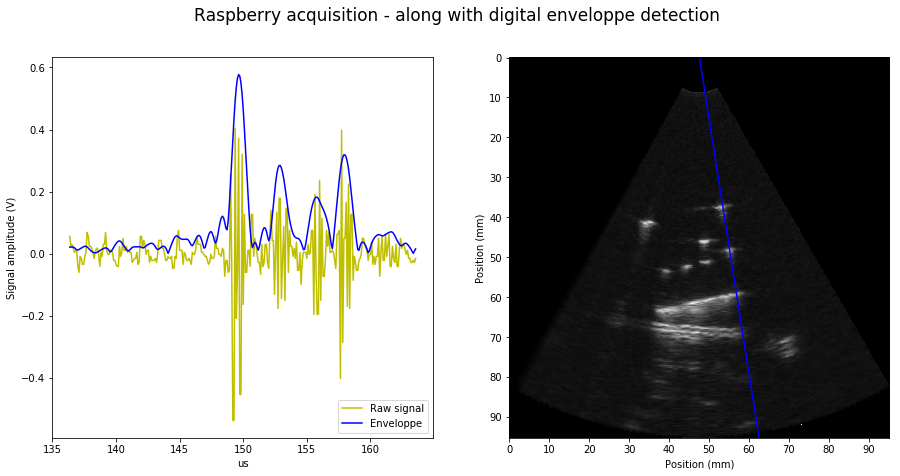Acquisition of the raw ultrasound image
Taking advantage of a Vref/2 offset at the ADC level
import matplotlib.pyplot as plt
import numpy as np
from scipy import signal
import scipy.signal.signaltools as sigtool
from scipy.interpolate import griddata
import math
npzfile = np.load("GainB.npz")
print(npzfile.files)
Image = npzfile["RawData"]
RawData = np.asarray(Image,dtype = np.int32)
#Changing lines with strange behaviors
Vars = np.var(RawData,1)/1000
for i in range(len(Vars)):
if (Vars[i]>1):
RawData[i] = RawData[i-1]
['RawData']
plt.imshow(np.transpose(RawData)[0:2000],aspect="auto",cmap=plt.get_cmap('gray'))
plt.show()
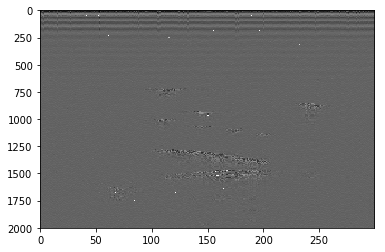
Let's see what one line looks like.
We should see an echo, offset by Vref / 2, for a 9 bit ADC, that's an offset of 256 (or 1.65V )
tmpline = RawData[70]
plt.figure(figsize=(15,5))
t = [x / 11.0 for x in range(len(tmpline))]
plt.plot(t[100:2000],tmpline[100:2000]*3.3/512.0)
plt.xlabel("Time (us)")
plt.ylabel("Measure (V)")
plt.show()
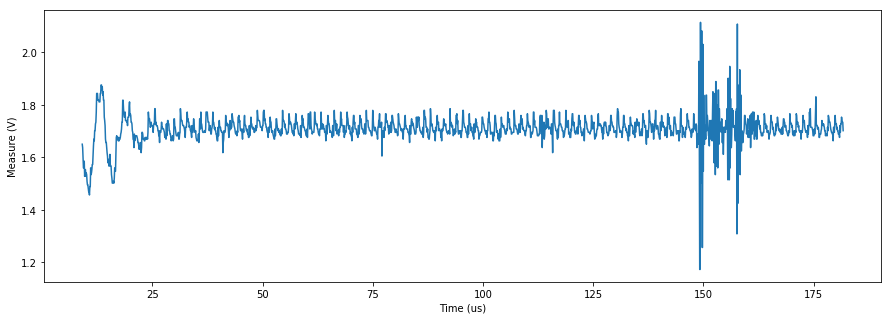
def ProcessLine(Line):
LenLines = len(Line)
FFTMap = []
Min = np.average(Line[8000:9000])
for k in range(LenLines-1):
if (Line[k+1] > 400):
Line[k+1] =(RawData[l][k] + RawData[l][k+2])/2
FFTed = np.fft.fft(Line)
for i in range(3000):
FFTed[i] = 0
FFTed[-i] = 0
for i in range(1000):
FFTed[4000+i] = 0
FFTed[-i-4000] = 0
SigFil = np.real(np.fft.ifft(FFTed))[0:2400]
return Line-Min,SigFil
Line,Filtered = ProcessLine(Image[70])
SigHF = np.abs(signal.hilbert(Filtered))
SigH = np.abs(signal.hilbert(Line))
t = [x / 11.0 for x in range(len(Line))]
fig, ax = plt.subplots( nrows=2, ncols=2,figsize=(15,5))
ax[0,0].plot(t[1500:1800],Line[1500:1800]*3.3/512,"r") # plotting 50x 100ns, that's 5µs
ax[1,0].plot(t[1500:1800],(SigH)[1500:1800],"g" ) # plotting 50x 100ns, that's 5µs
ax[0,1].plot(t[1500:1800],Filtered[1500:1800]*3.3/512,"r") # plotting 50x 100ns, that's 5µs
ax[1,1].plot(t[1500:1800],(SigHF)[1500:1800]/10,"g" ) # plotting 50x 100ns, that's 5µs
plt.show()

plt.figure(figsize=(15,5))
plt.plot(t[1500:1800],Line[1500:1800]*3.3/512,"r")
plt.plot(t[1500:1800],(SigHF)[1500:1800]/100,"g")
plt.xlabel("Time in uS")
plt.title("Extracting the enveloppe with Hilbert")
plt.show()

NbLines, LenLines = np.shape(RawData)
OffSets = []
FFTMap = []
Small = []
Cleaned = []
Hilberted = []
tmp = RawData[0][100:200]
for l in range(NbLines):
Line,Filtered = ProcessLine(RawData[l])
BegLine = Line[100:250]
Corr = 0 #signal.correlate((tmp-260)/40, (BegLine-260)/40, mode='same')
ACorr = np.argmax(Corr) #
OffSets.append((ACorr))
Small.append(RawData[l][0:2200])
Cleaned.append(np.abs(Filtered))
Hilberted.append(np.abs(signal.hilbert(Filtered)))
tmp = np.fft.fft(Line)
FFTMap.append(tmp)
OffMax = max(OffSets)
Mapping the frequency domain
There seems to be a sort of folding, plus some strips remaining
plt.figure(figsize=(15,5))
plt.imshow(np.sqrt(np.abs(FFTMap)),aspect="auto")
plt.show()
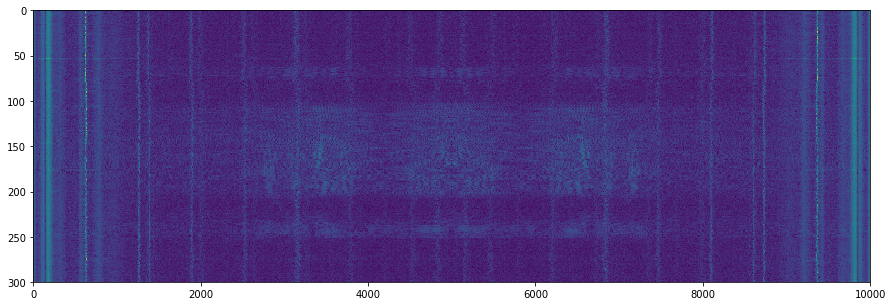
FFT = (np.abs(FFTMap)[0]**2)/0.6e6
MainFreq = np.array(FFT, dtype=np.int)
f= [1.0*x/len(MainFreq)*11 for x in range(len(MainFreq))]
plt.plot(f[0:len(MainFreq)/2],FFT[0:len(MainFreq)/2])
plt.ylim([0,3])
plt.show()
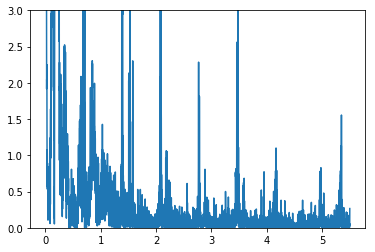
Size
Without decimation, we have on line the right gabarit. We find that resolution is 14.93 px / mm. That's around 15px / mm.
The speed of sound is 1500m/s, so on the image we have 1.332us/mm.
- Acquisition speed is therefore 14.93/1.332 is 11.2Msps.
- The acquarium wall is at 100mm, that should be 1493px
Decimation = 5
DecSL = 3
NotCentered = 224
NbLinesC = NbLines/Decimation
LenLinesC = LenLines+OffMax+NotCentered+1
def CreateImage(Hilberted):
NbLines, LenLines = np.shape(Cleaned)
Image = np.abs(Cleaned)
Corrected = np.zeros((NbLines, LenLines+OffMax+NotCentered))
RawImage = np.zeros((NbLines/Decimation, LenLines+OffMax+NotCentered))
SmallTwo = np.zeros(np.shape(Small))
for i in range(NbLines):
for j in range(LenLines-OffMax):
Corrected[i][j+NotCentered] = Hilberted[i][j-OffSets[i]+OffMax]
if (j<1500):
SmallTwo[i][j+NotCentered] = Small[i][j-OffSets[i]+OffMax]
Corrected[97] = Corrected[96]
Corrected = Corrected-np.amin(Corrected)
Corrected = np.sqrt(Corrected)
for j in range(NbLines/Decimation):
for k in range(Decimation):
RawImage [j] += Corrected[Decimation*j+k]
print (LenLines-OffMax)/DecSL
RawImg = np.zeros((NbLines/Decimation, (LenLines-OffMax)/DecSL))
for i in range(NbLines/Decimation):
for j in range((LenLines-OffMax)/DecSL):
for k in range(DecSL):
RawImg [i][j] += (RawImage[i][DecSL*j+k])
return RawImg
print NbLines
300
RawImg = CreateImage(Hilberted)
CleanedImage = CreateImage(Cleaned)
np.shape(RawImg)
800
800
(60, 800)
f, axarr = plt.subplots(1,2,figsize=(15,5))
axarr[0].imshow(RawImg,cmap=plt.get_cmap('gray'),aspect='auto',)
axarr[1].imshow(CleanedImage,cmap=plt.get_cmap('gray'),aspect='auto',)
plt.show()

def CreateSC(RawImgData):
LenLinesC = np.shape(RawImgData)[1]
SC = np.zeros((LenLinesC,LenLinesC))
SC += 1
maxAngle = 60.0
step = maxAngle/(NbLinesC+1)
CosAngle = math.cos(math.radians(30))
Limit = LenLinesC*CosAngle
points = []
values = []
for i in range(LenLinesC):
for j in range(LenLinesC):
if ( (j > LenLinesC/2 + i/(2*CosAngle)) or (j < LenLinesC/2 - i/(2*CosAngle)) ):
SC[i][j] = 0
points.append([i,j])
values.append(0)
if ( (i > Limit) ):
if ( (i**2 + (j-LenLinesC/2) ** 2) > LenLinesC**2):
SC[i][j] = 0
points.append([i,j])
values.append(0)
for i in range(NbLinesC):
PointAngle = i*step-30
COS = math.cos(math.radians(PointAngle))
SIN = math.sin(math.radians(PointAngle))
for j in range(LenLinesC):
X = (int)( j*COS)
Y = (int)(LenLinesC/2 - j*SIN)
SC[X][Y] = RawImgData[i][j]
points.append([X,Y])
values.append(RawImgData[i][j])
values = np.array(values,dtype=np.int)
return SC,values,points,LenLinesC
SCH,valuesH,pointsH,LenLinesCH = CreateSC(RawImg)
SCC,valuesC,pointsC,LenLinesCC = CreateSC(CleanedImage)
f, axarr = plt.subplots(1,2,figsize = (15,7))
axarr[0].imshow(SCH)
axarr[1].imshow(SCC)
plt.show()
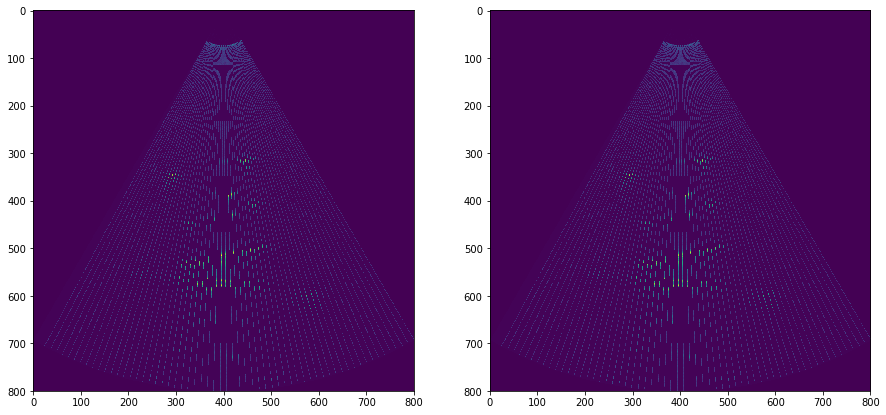
grid_xH, grid_yH = np.mgrid[0:LenLinesCH:1, 0:LenLinesCH:1]
grid_xC, grid_yC = np.mgrid[0:LenLinesCC:1, 0:LenLinesCC:1]
#grid_z0 = griddata(points, values, (grid_x, grid_y), method='nearest')
grid_z1H = griddata(pointsH, valuesH, (grid_xH, grid_yH), method='linear')
grid_z1C = griddata(pointsC, valuesC, (grid_xC, grid_yC), method='linear')
grid_z1 = griddata(pointsH, valuesH, (grid_xH, grid_yH), method='cubic')
f, axarr = plt.subplots(1,2,figsize = (15,7))
axarr[0].imshow(grid_z1H,cmap=plt.get_cmap('gray'))
axarr[1].imshow(grid_z1C,cmap=plt.get_cmap('gray'))
plt.show()
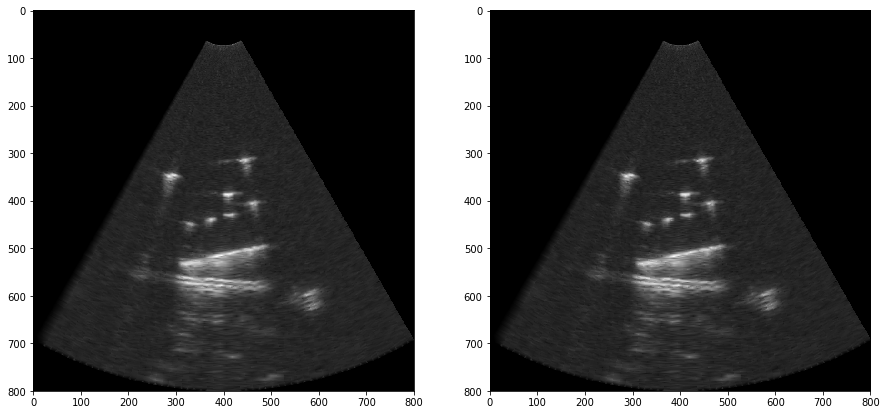
Line,Filtered = ProcessLine(Image[70])
SigHF = np.abs(signal.hilbert(Filtered))
SigH = np.abs(signal.hilbert(Line))
t = [x / 11.0 for x in range(len(Line))]
mmVal = []
mmLbl = []
step = 60/(NbLinesC+1)
f, axarr = plt.subplots(1,2,figsize = (15,7))
f.suptitle("Raspberry acquisition - along with digital enveloppe detection",fontsize = "17")
axarr[0].set_xlabel("us")
axarr[0].set_ylabel("Signal amplitude (V)")
axarr[0].plot(t[1500:1800],Line[1500:1800]*3.3/512,"y", label='Raw signal')
axarr[0].plot(t[1500:1800],(SigHF)[1500:1800]/100,"b", label='Enveloppe')
axarr[1].plot( [np.shape(grid_z1)[1]*(0.5), np.shape(grid_z1C)[1]*(1-103.0/300)],[0,np.shape(grid_z1C)[1]],'b')
for k in range (np.shape(grid_z1)[1]):
if not(k%int(112*0.75)):
mmVal.append(k)
mmLbl.append(int(k/(11.2*0.75)))
plt.xticks(mmVal,mmLbl)
plt.yticks(mmVal,mmLbl)
axarr[1].set_xlabel("Position (mm)")
axarr[1].set_ylabel("Position (mm)")
axarr[0].legend(loc='lower right')
axarr[1].imshow((grid_z1C**1.4),cmap=plt.get_cmap('gray'))
plt.savefig('LineImageEnveloppe.jpg', bbox_inches='tight')
plt.show()
/usr/local/lib/python2.7/dist-packages/ipykernel/__main__.py:26: RuntimeWarning: invalid value encountered in power
